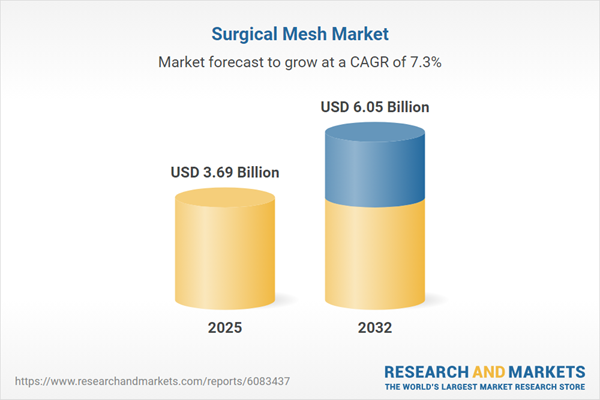Speak directly to the analyst to clarify any post sales queries you may have.
The surgical mesh market is evolving rapidly amid rising clinical needs, technological advancement, and shifting regulatory and trade environments. Senior leaders must stay ahead of industry dynamics to mitigate risk and identify growth opportunities as patient care demands transform global supply chains.
Market Snapshot: Growth in the Surgical Mesh Market
The Surgical Mesh Market grew from USD 3.45 billion in 2024 to USD 3.69 billion in 2025. It is expected to continue growing at a CAGR of 7.27%, reaching USD 6.05 billion by 2032. This trajectory is propelled by expanding applications in minimally invasive and reconstructive surgeries, increasing adoption of advanced mesh technologies, and robust demand across mature and emerging healthcare systems.
Scope & Segmentation
- Product Types: Absorbable mesh (including polyglactin and polyglycolic variants) and non-absorbable mesh (such as expanded polytetrafluoroethylene, polyester, and polypropylene mesh).
- Fixation Techniques: Methods include biological and synthetic adhesives, continuous or interrupted sutures, and both absorbable and non-absorbable tack systems.
- Source Types: Biological meshes derived from animal tissues and synthetic meshes tailored for mechanical strength and scalability.
- Applications: Utilization spans breast reconstruction, hernia repair, pelvic organ prolapse, reconstructive surgery, stress urinary incontinence, and management of traumatic or surgical wounds.
- End Users: Hospitals, clinics, and ambulatory surgical centers, each with unique procurement and procedural requirements.
- Regional Coverage: The Americas (North America and Latin America), Europe, Middle East & Africa, and Asia-Pacific. Markets such as the United States, Germany, China, and India play significant roles both as producers and high-volume consumers.
- Leading Companies: Market players include 3M Company, B. Braun Melsungen AG, Boston Scientific Corporation, Johnson & Johnson Services, Inc, Medtronic PLC, Coloplast Corp., W. L. Gore & Associates, Inc., and several niche innovators and regional specialists.
Key Takeaways for Decision-Makers
- Innovation in surgical mesh centers on advanced polymers, hybrid biologic-synthetic composites, and drug-eluting coatings to enhance biocompatibility and patient outcomes.
- Regulatory standards are adapting to accommodate the integration of new materials and methods, impacting product approval timelines and evidence generation requirements.
- Collaboration among academic centers, industrial developers, and healthcare providers is accelerating clinical validation and driving real-world adoption of new mesh solutions.
- Regional regulatory frameworks, reimbursement paradigms, and local infrastructure investments shape procurement strategies and market entry decisions.
- Digital health platforms, remote monitoring, and real-time procedural analytics are improving post-operative outcomes and informing continuous product improvement cycles.
Tariff Impact on Surgical Mesh Supply Chains
New tariff measures in the United States are set to influence the surgical mesh market by driving up the costs of imported raw materials and finished components. Manufacturers will need to re-evaluate sourcing and production strategies to offset supply chain pressures. This will likely result in greater emphasis on regional suppliers, vertically integrated manufacturing, and strategic agreements with local partners.
Methodology & Data Sources
This report employs a robust research methodology combining structured interviews with clinicians, procurement leaders, and regulatory specialists. It also includes systematic reviews of regulatory filings, industry literature, and competitive intelligence on emerging product technologies and innovation trends.
Surgical Mesh Market: Why This Report Matters
- Enables stakeholders to benchmark strategic planning, market penetration, and innovation investments against current industry realities.
- Delivers actionable insights into shifting regulatory requirements, tariff policies, and procurement dynamics to inform resilient decision-making.
- Supports risk mitigation across supply chain, R&D, and market access initiatives, empowering organizations to maintain competitive advantage.
Conclusion
The surgical mesh market will reward organizations that leverage innovation, supply chain agility, and data-driven insights to navigate industry complexity. This report provides clarity to support effective strategies across evolving segments and global regions.
Table of Contents
3. Executive Summary
4. Market Overview
7. Cumulative Impact of Artificial Intelligence 2025
Companies Mentioned
The companies profiled in this Surgical Mesh market report include:- 3M Company
- Angiologica B.M. S.r.l.
- Aran Biomedical
- ASSUT Europe S.p.A.
- B. Braun Melsungen AG
- Becton, Dickinson and Company
- Betatech Medical
- BG Medical LLC
- BioCer Entwicklungs-GmbH
- Boston Scientific Corporation
- Coloplast Corp.
- Cousin Biotech SAS
- Deep Blue Medical Advances, Inc.
- Dipromed Srl
- Dolphin Sutures
- Integra LifeSciences Corporation
- Johnson & Johnson Services, Inc
- KLS Martin Group
- Lotus Surgicals
- Medtronic PLC
- Novus Scientific AB
- Tela Bio, Inc.
- THT Bio-Science
- Vitrex Medical A/S
- W. L. Gore & Associates, Inc.
Table Information
| Report Attribute | Details |
|---|---|
| No. of Pages | 192 |
| Published | November 2025 |
| Forecast Period | 2025 - 2032 |
| Estimated Market Value ( USD | $ 3.69 Billion |
| Forecasted Market Value ( USD | $ 6.05 Billion |
| Compound Annual Growth Rate | 7.2% |
| Regions Covered | Global |
| No. of Companies Mentioned | 26 |








